By David M. Bunis, Schusterman Visiting Professor of Israel Studies
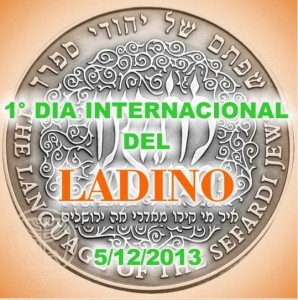
The official insignia of the first International Ladino Day, whose name quickly became a source of controversy. Image courtesy of esefarad.com.
Early in 2013, Zelda Ovadia of the Jerusalem Kol Israel radio program, which broadcasts in the traditional language still used today by some descendants of medieval Spanish Jewry, conceived and publicized an idea which at once focused world attention on the language of the Sephardim, and helped unite its widely dispersed speakers. She proposed that December 5th be recognized throughout the world as El Dia Internasional del Ladino—International Ladino Day, with day-long festivities to be held in Israel and in Diaspora Sephardic communities everywhere. Preparations for the event, and the celebration of the day itself, united many Sephardim worldwide, bringing to mind the Sephardic proverb: “Komo el ahaduth de los djudios no ay”—There is no unity like that of the Jews.
This unity lasted for about a day. The day after the celebration there came a backlash, predictable to those familiar with this community, well illustrating another Sephardic proverb: “Dos djudios en tres keiloth”—Two Jews require three synagogues (since, in addition to one’s own, one must have another synagogue which one would never deign to enter). The problem in this case revolved around an issue to which members of the modern speech community have been sensitive for years: how to call their language.
Since the 1970s, Professor Haim Vidal Sephiha of Paris, a linguist and himself a native speaker of the language, has insisted that the name “Ladino” only be used to denote the archaic variety of the language used since the Middle Ages for translating sacred Hebrew texts such as the Bible in a highly literal manner. For Sephiha, the expression “avlar en ladino” (to speak Ladino) is a contradiction in terms, since, to his thinking, one should only use “Ladino” in the context of artificial translations, never for ordinary, original speech.
On the other hand, Yitzhak Navon, fifth president of the State of Israel, and Moshe Shaul, vice-president of the Israel National Authority for Ladino Culture, which Navon and Shaul helped to found in 1997, use “Ladino” to denote the language of the Sephardim in all its varieties, written and spoken, and also use “Ladino culture” to denote the group’s cultural traditions.
Who’s right?
The answer lies in the traditional Jewish tendency to distinguish between features which characterize Jews, and opposing features which are instead typical of the ‘other,’ the non-Jews. Similar distinctions were also made by other ancient peoples, such as the Greeks and Chinese.
What we know about Sephardic traditions of the past derives primarily from the writings of the group’s rabbis. They traditionally used the term “Ladino” in the same sense that they used the Hebrew word “La’az” (לעז) when writing in Hebrew: namely, “the foreign language of the ‘other,’ of another people, as opposed to Hebrew, our language, the language of the Jews.” In the Hebrew version of Psalms 114:1 we read “Be-tset Yisrael mi-Mitsrayim, bet Ya’aqov me-‘am lo’ez”—When Israel came forth out of Egypt, the house of Jacob from a people of strange (or foreign, non-Jewish) language,” i.e., Ancient Egyptian. The Sephardic rabbis translated the phrase “a people of foreign language” into the archaic variety of Jewish Castilian in which they traditionally translated the Bible literally as “puevlo ladinán”—“a people using Ladino” (which derives from Latin Latinus, denoting ‘Latin’), meaning the foreign (i.e., non-Hebrew) language used by the non-Jewish host group in the place and time in which Sephardic culture first arose, medieval Spain. (The selection of that word was probably helped along by the fact that “Ladino” sounded more like “La‘az” than other candidates for naming the language, such as “Romance” or “Español.”)
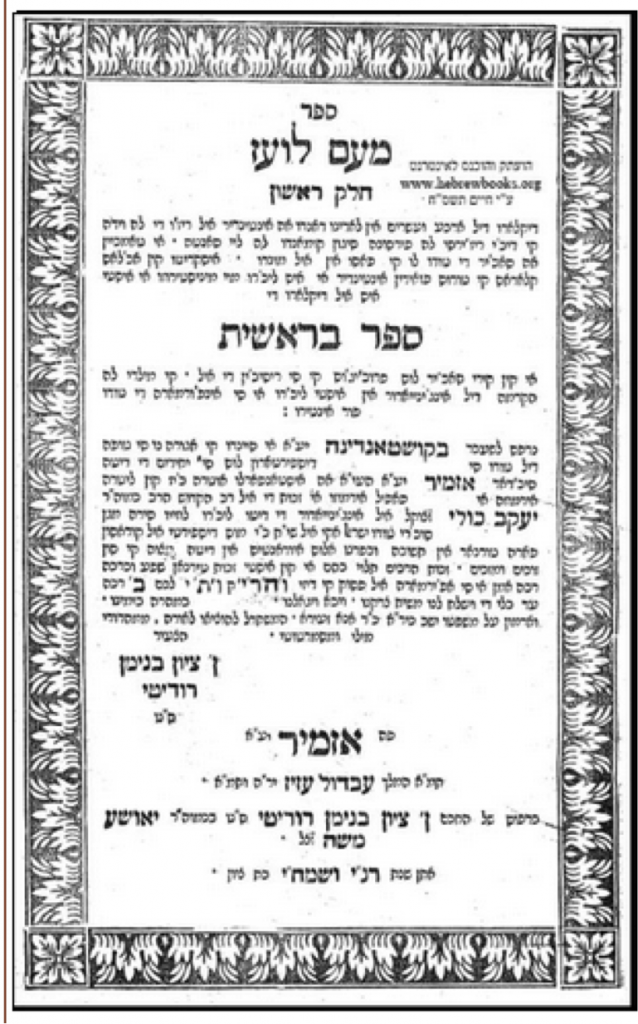
R. Ya’akov Khulí, Me-am lo’ez: Genesis, Izmir 1864 edition. Image courtesy of hebrewbooks.org.
When writing original works in Hebrew, Sephardic rabbis sometimes used “La’az” in the sense of a written variety of their vernacular. For example, as when Rabbi Yosef Karo (b. Toledo 1488) deliberated in his Bet Yosef (Orach Hayyim 307) about the permissibility on the Sabbath of reading “sippure milhamot”—war stories—“bi-leshon ha-kodesh” (in the Holy Tongue, i.e., Hebrew) as opposed to those “ha-ketuvim bi-leshon La‘az” (written in the “foreign tongue” [i.e., in the Jewish Castilian of the Sephardim]).
But sometimes the rabbis used “La‘az” in the sense of the everyday language spoken by the Sephardim, as when Rabbi Moshe ben Hayyim Shabbetai of 17th-century Salonika reported, in his responsa collection Torat Moshe (Hoshen Mishpat, no. 10), on a case in which one person had asked another, in speech, whether or not to buy something, “we-hishiv lo … bi-leshon la‘az ‘Merka, ke kolay será ‘ ” (and the other answered him [speaking the words] … in the La‘az language “Buy it, because it will be easy”). Rabbi Nissim Hayyim Moshe Mizrachi of 18th-century Jerusalem, in his responsa collection Admat Kodesh (vol. 1, Yore De’a, no. 12), discussed the significance of certain words of “Reuven … ke-še-amar ha-devarim be-la’az she-perusham she-kibbel neziruto” (Reuven … when he said the words in La‘az the meaning of which is that he undertook to abstain from drinking alcohol). In all three examples—the first, a reference to written literary language, the second and third, to forms of the spoken language (the second, including the Turkish-origin word kolay ‘easy,’ often used in colloquial speech)—the language of the Sephardim was denoted in Hebrew by “La‘az.”
So, too, the Sephardic rabbis traditionally distinguished in their everyday language between “Ladino” (their vernacular equivalent of Hebrew “La‘az,” meaning their everyday, if “foreign-origin,” tongue) and “Lashón Hakodesh,” or simply “Lashón,” meaning Hebrew. They sometimes used “Ladino” to denote the archaic, artificial literal translation language referred to by Professor Sephiha, as when a bilingual edition of Pirke Avoth published in Belgrade in 1905 was described on its title page as being “en lashón i ladino” (in Hebrew and Ladino).
But they sometimes used “Ladino” to refer to spoken language. For example, as when Rabbi Yaakov Khulí, born in Erets Yisrael in the 17th century, wrote in his exegetic work Me-Am Lo’ez on Exodus (Constantinople 1733: 92a) that “Los misriyim … se yaman am loéz porke no savian avlar lashón akódesh si no en ladino” (The Egyptians … are called a people speaking a foreign language because they did not know how to speak the Holy Tongue but only in a foreign language [which, according to Sephardic tradition, Rabbi Khulí denoted by “Ladino”]). (It should be noted that, on the title page of his book, Khulí said that it was written “in Ladino,” meaning that it was in the vernacular of his readers—although not in the archaic, literal sacred-text translation style—rather than in Hebrew, the language more usual in rabbinical writings.)
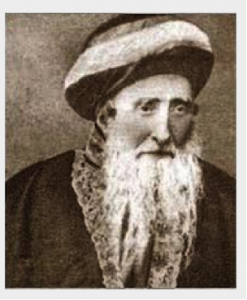
Rabbi Avraham Palachi (1809-1899), a chief rabbi of Izmir.
Similarly, Rabbi Avraham Palachi, a chief rabbi of Izmir (Turkey) in the 19thcentury, wrote in his moralistic work We-hokhiah Avraham (Salonika 1853: 7a) that “el ladino ke avlamos por nuestra parte no es aunado kon otros lugares en kuantos biervos, ke son demudados” (the Ladino that we speak in our parts is not identical with other places in a few words, which are different). Here again, “Ladino” was used in the context of speech, in unstated opposition to Hebrew, the language in which Rabbi Palachi said he was more used to writing.
In 1861, Rabbi Eliezer ben Shem Tov Papo of Sarajevo warned that mentioning or saying the name of God in vain was prohibited not only in Hebrew, but also in other languages spoken by Ottoman Jews, such as those he called “ladino,” “lashón di lus guyim” (Serbian), and “trukesku” (Turkish): “Inmintar il nombri di il Shem Yidbarah no es asur davká in lashón akódish, salvu in todu modu di lashón es asur, tantu in ladinu, komu lu ki uzan a dizir ‘A la ira dil Dio,’ i ansí in lashón di lus guyim ‘Bogami,’ … i ansí si dizi in trukesku ‘Valá bilá’” (Mentioning the name of the Name [=God] Blessed Be He is not prohibited only in the holy tongue, but in every type of language it is forbidden, both in Ladino, as they are used to saying [in the everyday spoken language] “A la ira dil Dio” [To God’s anger], and thus in the language of the Gentiles [=Serbian], “Bogami” [By God], … and the same if one says in Turkish “Valá bilá” [By God]) (Sefer Dameseq Eliezer, Orah Hayyim, Belgrade 1861: ff. 8a-8b).
In the twentieth century, Isaac Arditi, in the popular newspaper El Meseret of Izmir (vol. 23, September 9 1919, p. 40), sarcastically wrote about a grumpy rabbinical scholar in his community who “shabat entero … no aze ke meldar en lashón i en ladino pelear” (the whole day of Shabbat … does nothing but study in Hebrew and fight around in Ladino).
Дарение эмпирических подарков также укрепляет социальные связи между дарителями и получателями. Подробнее: Коронавирус усилил виртуальную реальность — вот как избежать антиутопии. Переподарить: переподарить, что подарить маме на 8 марта если сделать это вдумчиво, может быть
From such examples we can see that, over the centuries, “Ladino” has been used to denote the language of the Sephardim both in its written forms—including, but not limited to, that used in the literal translation of sacred texts—and in its spoken forms, especially when an opposition to Hebrew is stated or implied. Thus, especially in the context of Israel—where Hebrew is the everyday spoken and written language to which the special language of the Sephardim is juxtaposed, and where El Dia Internasional del Ladino was first conceived and received its name—the reference to the language of the Sephardim, in all of its spoken and written varieties, as “Ladino” is not a mistake but a preservation of a centuries-old Sephardic tradition.
The use of “Ladino” in this sense does not detract one iota from the seminal contributions of Professor Sephiha to the study of the unique, archaic calque variety of the language used by the Sephardim to translate sacred Hebrew and Aramaic texts. At the same time, its use in expressions such as “Ladino culture” brings today’s Sephardic terminology in sync with the current trend to denote the culture of a speech group by the name used to denote the language itself (e.g., “Yiddish culture”). In everyday speech and writing, and in websites dedicated to this culture, such as Ladinokomunita—which has itself decided to adopt “Ladino” as the preferred name for the language—native speakers have begun to incorporate “Ladino” into neologisms referring to themselves, such as “Ladino-avlantes” (Ladino speakers), and, here in Seattle, “los Ladineros.” This name, coined by Seattle community member Jack Altabef, refers to an intergenerational group of Ladino speakers who gather every week to read Ladino texts and discuss Ladino culture.
As implied by the Sephardic proverb “Bos del puevlo, bos del Syelo” (The voice of the people is the voice of Heaven), it’s hard to fight the will of the people. And in the case of the name to be used for their language and culture, the will of the majority of Sephardim seems to fall with “Ladino.”
David M. Bunis is Professor in the Department of Hebrew Language at the Center for Jewish Languages and Literatures at the Hebrew University in Jerusalem. A world expert on the Ladino language (also known as Judezmo), he is the Schusterman Visiting Professor of Israel Studies at the University of Washington for 2013-14.



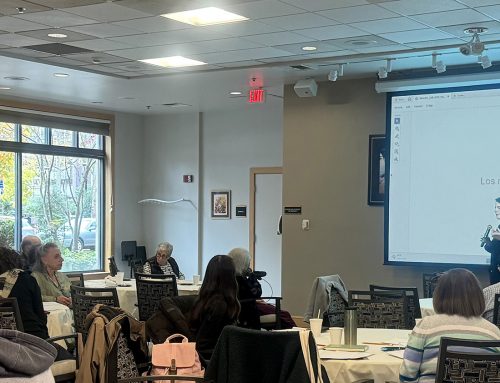


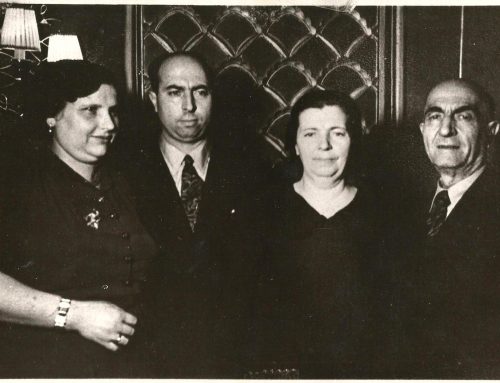
I am one of the individuals that attend the weekly Ladino class that Professor Bunis makes reference to in his article. We have about 20 plus attendees every week and we discussed this very subject for two or three weeks recently, utilizing the Digests from Ladinokomunita, which was filled with emails regarding using the term ‘Ladino’ or not. Professor Bunis did an excellent job discussing the pros and cons in detail. As an aside, all of the people that make up our class, with possibly two or three exceptions, have only heard the term ‘Ladino’ applied to the language spoken by our parents and the pioneers that came to Seattle during the early years of the twentieth century.
I was born in Morocco and my maternal language is Haketia- the Judeo-Spanish spoken mainly in Northern Morocco. At home we called our language “Español”, and only years later I realized that it is a Judeo Spanish dialect that sprung from Spanish, but not pure Spanish. We, the Haketia speakers, make a clear distinction between the Haketia—which is the vernacular, (composed mainly of medieval Spanish, with additions from Hebrew, Arabic, Portuguese, and some French and English), and the “Ladino”- the literary /written language (composed of medieval Spanish with only some Hebrew and Aramaic, when it came to religious matters).
The Sephardim of the Eastern Mediterranean, just like us from Morocco, made a clear distinction between these two: A vernacular that is a mixture of Medieval Spanish with local languages, and the ‘Ladino” — without vocabulary from the local languages (I. E. without vocabulary from Turkish, Greek, Slavic, Arabic, etc. ).
The vernacular that is being called now a days “Ladino” was never called “Ladino” before Mr. Navon and Mr. Moshe Shaul started their name-change campaign about 40 years ago. Professor H.V. Sephiha is not alone in objecting this fictitious name-change. Please refer to Paloma Diáz –Mas, to other scholars, and to a wealth of testimonies by Sephardim from the Balkans and Turkey who object this name-change as well.
Before the name-change campaign by Ms. Navon and Mr. Shaul, it was called in Israel “Spaniyolit” and in the Balkan, Turkey and Greece it was called Djudio, Djudio, Spaniyol, etc., but never Ladino! Similar to the Judeo-Spanish speakers in Morocco, the Sephardim of Eastern Mediterranean made a clear distinction between their vernacular and the literary language.
Alicia Sisso Raz
http://www.vocesdehaketia.com
[This comment has been edited for length.]
I am the granddaughter of David and Esther (Adatto) Levy who were Sephardic pioneers being the first Sephardic couple married in Seattle (by the Ashkenazi rabbi) after my grandfather arrived from the Island of Marmara and my grandmother came with a group of women from Tequirdaj (Rodosto) (SP?). My mom Dorothy Levy Inerfield was fluent in what she always referred to (in English) as Spanish but unfortunately did not teach it to me and my two sisters. However, we visited my grandmother often and my sister remembers them referring to the spoken language as Judesmo.
Hello Janice,
Thanks very much for bringing these family and Seattle-Sephardic-community facts to my attention!
I’ll add Tekirdag/Rodosto to the long list of places in which Sephardim referred to their language as Judesmo.
Professor Bunis will no doubt recollect that in a meeting held in Livorno some years ago (where Navon was present) I was unexpectedly asked to speak to those present and I chose to speak not in Italian but in my Istanbul brand of Judeo-Spanish. This is because Rav Elio Toaf told me that his father, the Rav Sabato Toaf, told him that the HIDA, who lived in the later pat of his life in Livorno, used to have a minyan at home throughout the year, but on Yom Kippur used to attend the famous Synagogue (which was destroyed during the war) and preach in Judeo-Spanish… So in relatively recent times Judeo-Spanish was in use there…
Anyway, the Community’s archives in Livorno contain a great number of documents said to be in Spanish (and sometimes in Portuguese) but I wonder if these old texts, written there a century or more after the writers had left Spain, are in pure Spanish or are already in a primitive form of Judeo-Spanish! At what stage did Spanish start changing?
Best regards.
Giacomo Saban
Mi abuelo le decía ladino en su Rodas natal.
Hace más de 40 años que lo hacía.
Y lo hacía él y los miles de inmigrantes de muchas comunidades sefaradíes europeas en particular de Esmirna y de Rodas que llegaron a la Argentina.
Se usaba djudezmo también pero más común era ladino.
Así como es fácil distinguir entre “Espanyol” y “Judeo-español” para quien haya nacido en Marruecos (ver comentario de Alicia Sisso); también yo sé distinguir entre el ladino calco y el vernáculo.
¿Debo llamarlo judeoespañol menospreciando la Haketia, hermoso lenguaje judeoespañol?
¿Qué diría mi abuelo Asher (z’l), nacido en el siglo XIX, si le cambio el nombre que él mismo me enseñó?
¿Debo yo cambiar la tradición que me transmitieron?
¿Sería eso tradición? ¿o traición?
¿Que pasaría si los pueblos tomaran en cuenta solo los aspectos académicos sin importar lo que el propio pueblo dice?
Vox populi vox Dei.
Encontramos en el habla natural de la gente infinidad de términos “mal usados” que luego se convierten en correctos.
Again, Voz populi, vox Dei. (salvo que se quiera dejar de lado al pueblo)
¿De qué sirve esta discusión?
¿Qué pasaría si yo me pongo a corregir los términos técnicos que se mal-usan cotidianamente en las redes? ¿Qué pasarís si solo queda lo académico y nos despegamos del pueblo?
Seguramente quedaría una haketía, o un ladino, o un judeoespañol para muy pocos. Y por poco tiempo…
El enriquesimiento de la lengua por parte del pueblo es la misma escencia de estas lenguas judeoespañolas.
Nótese en el comentario del querido Isaac Azose que personas del mismo origen en Seattle también le decían ladino a la lengua que hablaban y no creo que Navon haya estado por allí predicando ningún cambio de nombre.
Y finalizo repitiendo una pregunta de la que no tengo respuesta ¿Para qué sirve esta discusión?
O si tengo la respuesta: Para nada.
When I was growing up in Florentin,in south Tel Aviv,where nearly everybody -those who didn’t go to Auschwitz-was from Saloniki,nobody spoke Ladino,we spoke Spanyolit.Yet no mention is mention is made of the fact that the people, perhaps not very learned,referred to their language as such.Why?
In the Thessaloniki of my childhood pre WW II the language in question
was known as “Espaniol” or “Judesmo”by the Jews and “Evraica” by the gentiles. I only heard the term “Ladino” when I came to the US. With all due respect to the war rabbis, I think that the term “Ladino” is now well well established and clarifies its object
for all.